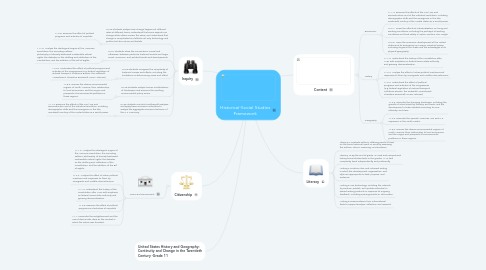
1. Inquiry
1.1. HAS2-Students analyze how change happens at different rates at different times; understand that some aspects can change while others remain the same; and understand that change is complicated and affects not only technology and politics but also values and beliefs.
1.1.1. 11.2.8. Examine the effect of political programs and activities of Populists.
1.2. HAS1-Students show the connections, causal and otherwise, between particular historical events and larger social, economic, and political trends and developments.
1.2.1. 11.1.2. Analyze the ideological origins of the American Revolution, the Founding Fathers’ philosophy of divinely bestowed unalienable natural rights, the debates on the drafting and ratification of the Constitution, and the addition of the Bill of Rights.
1.3. HAS2-Students recognize the complexity of historical causes and effects, including the limitations on determining cause and effect.
1.3.1. 11.2.9. Understand the effect of political programs and activities of the Progressives (e.g.,federal regulation of railroad transport, Children’s Bureau, the Sixteenth Amendment, Theodore Roosevelt, Hiram Johnson).
1.4. HAS5-Students analyze human modifications of landscapes and examine the resulting environmental policy issues.
1.4.1. 11.8.6. Discuss the diverse environmental regions of North America, their relationship to local economies, and the origins and prospects of environmental problems in those regions.
1.5. HAS6-Students conduct cost-benefit analyses and apply basic economic indicators to analyze the aggregate economic behavior of the U.S. economy.
1.5.1. 11.1.4. Examine the effects of the Civil War and Reconstruction and of the industrial revolution, including demographic shifts and the emergence in the late nineteenth century of the United States as a world power.
2. Citizenship
2.1. Civics and Government
2.1.1. 11.1.2. Analyze the ideological origins of the American Revolution, the Founding Fathers’ philosophy of divinely bestowed unalienable natural rights, the debates on the drafting and ratification of the Constitution, and the addition of the Bill of Rights.
2.1.2. 11.2.4. Analyze the effect of urban political machines and responses to them by immigrants and middle-class reformers.
2.1.3. 11.1.3. Understand the history of the Constitution after 1787 with emphasis on federal versus state authority and growing democratization.
2.1.4. 11.2.8. Examine the effect of political programs and activities of Populists
2.1.5. 11.1.1.Describe the Enlightenment and the rise of democratic ideas as the context in which the nation was founded.
3. United States History and Geography: Continuity and Change in the Twentieth Century -Grade 11
4. Content
4.1. Economics
4.1.1. 11.1.4. Examine the effects of the Civil War and Reconstruction and of the industrial revolution, including demographic shifts and the emergence in the late nineteenth century of the United States as a world power
4.1.2. 12.2.1. Know the effects of industrialization on living and working conditions, including the portrayal of working conditions and food safety in Upton Sinclair’s The Jungle.
4.1.3. 12.2.6. Trace the economic development of the United States and its emergence as a major industrial power, including its gains from trade and the advantages of its physical geography.
4.2. History
4.2.1. 11.1.3. Understand the history of the Constitution after 1787 with emphasis on federal versus state authority and growing democratization.
4.2.2. 11.2.4. Analyze the effect of urban political machines and responses to them by immigrants and middle-class reformers.
4.2.3. 11.2.9. Understand the effect of political programs and activities of the Progressives (e.g.,federal regulation of railroad transport, Children’s Bureau, the Sixteenth Amendment, Theodore Roosevelt, Hiram Johnson)
4.3. Geography
4.3.1. 11.2.2. Describe the changing landscape, including the growth of cities linked by industry and trade, and the development of cities divided according to race, ethnicity, and class.
4.3.2. 11.4.2. Describe the Spanish-American War and U.S. expansion in the South Pacific.
4.3.3. 11.8.6. Discuss the diverse environmental regions of North America, their relationship to local economies, and the origins and prospects of environmental problems in those regions.

